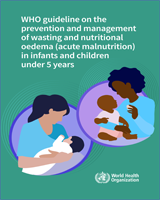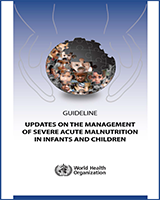1. Admission and discharge criteria for children who are 6–59 months of age with severe acute malnutrition
Admission criteria for children who are 6 to 59 months of age with severe acute malnutrition
Population
Children with severe acute malnutrition:
Children who are more than 6 months of age with a weight for height <−2 Z-score, or
Children who are 6–59 months of age, with a mid-upper arm circumference <125 mm
Urban/rural
Camp/no camps
Oedema/no oedema
Prevalence of oedema
Emergency/non-emergency
Community/health-care facilities
Active screening/passive screening.
HIV/TB prevalence
HIV/TB individual status
Discharge criteria for children who are 6–59 months of age with severe acute malnutrition
Population
Children above 6 months of age with severe acute malnutrition:
Control
For programme using mid-upper arm circumference: weight gain of 15–20% after oedema disappears
For programme using weight-for-height: weight-for-height >−11 standard deviation or weight gain of 15–20% after oedema disappears.
Outcomes
Mortality
Relapse
Adverse effects
Cost of treatment per child treated
2. Where to manage children with severe acute malnutrition who have oedema
Population
Children who are above 6 months of age with severe acute malnutrition:
Outcomes
Short-term mortality
Recovery rate
Time to recover
Weight gain
Use of resources
Adverse effects
Length gain
3. Use of antibiotics in the management of children with severe acute malnutrition in outpatient care
Population
Children who are under 5 years of age with severe acute malnutrition:
HIV positive/HIV negative/unknown
HIV-endemic settings/non-HIV-endemic settings
Under 6 months/above 6 months of age
Clinical signs of infection (to be defined)/no clinical signs of infection
Local sensitivity
Intervention
Amoxicillin, ampicillin, cephalosporin, chloramphenicol, ciprofloxacin co-trimoxazole, gentamicin, metronidazole
Control
No antibiotics, or
Different antibiotics
Outcomes
Mortality rate
Recovery rate
Adverse effects; relapse
Time to recover; weight gain
4. Vitamin A supplementation in the treatment of children with severe acute malnutrition
Effectiveness and safety of vitamin A supplementation in children with severe acute malnutrition
Population
Children who are under 5 years of age with severe acute malnutrition:
Presence of oedema/no presence of oedema
Presence of eye signs/no eye signs
HIV positive/HIV negative/unknown
HIV-endemic settings/non-HIV-endemic settings
Prevalence of vitamin a deficiency in the population
(+/− other sources of vitamin A, as national/local programmes of supplementation/fortification of vitamin A)
Under 6 months/above 6 months of age
Measles diagnosis (outbreak)
Intervention
Vitamin A single mega dose:
Outcomes
Mortality rate
Adverse effects (to be specified); morbidity
Recovery rate
Relapse
Time to recover; weight gain
5. Therapeutic feeding approaches in the management of severe acute malnutrition in children who are 6–59 months of age
Feeding outpatient children with severe acute malnutrition and diarrhoea
Population
Children who are under 5 years of age with severe acute malnutrition and diarrhoea, defined as:
Diarrhoea based on the mother recall or other definitions
With vomiting/without vomiting
Presence of oedema/no presence of oedema
Under 6 months/above 6 months of age
Persistent diarrhoea defined as more than 2 weeks
HIV positive/HIV negative/unknown
HIV-endemic settings/non-HIV-endemic settings
Breastfed/ non-breastfed
Outcomes
Referral to hospitals
Recovery from diarrhoea
Adverse effects
Time to recover from diarrhoea
Feeding inpatient children with severe acute malnutrition and diarrhoea
Population
Children who are 5 years of age with severe acute malnutrition and diarrhoea, defined as:
Diarrhoea based on the mother recall or other definitions
With vomiting/without vomiting
Presence of oedema/no presence of oedema
Under 6 months/above 6 months of age
Persistent diarrhoea defined as more than 2 weeks
HIV positive/HIV negative/unknown
HIV-endemic settings/non-HIV-endemic settings
Breastfed/ non-breastfed
Outcomes
Use of intravenous fluids
Recovery from diarrhoea; duration of diarrhoea
Adverse effects
Feeding children with severe acute malnutrition in the transition phase
Population
Children who are 6–59 months of age with severe acute malnutrition and return of appetite and most/all oedema disappeared:
Presence of oedema/no presence of oedema on admission
HIV positive/HIV negative/unknown
HIV-endemic settings/non-HIV-endemic settings
Intervention
Combination of F-75/ready-to-use therapeutic food with/without energy restriction, or F-100/ ready-to-use therapeutic food with/without energy restriction, or F-100 without energy restriction, or ready-to-use therapeutic food with/without energy restriction
Outcomes
Mortality rate; recovery rate
Cardiac embarrassment
Adverse effect (refeeding syndrome)
Relapse
6. Fluid management of children with severe acute malnutrition
Management of dehydration without shock due to diarrhoea (and vomiting) in children with severe acute malnutrition
Population
Children who are 5 years of age with severe acute malnutrition:
Dehydration based on the mother recall of watery diarrhoea or other definitions
With vomiting/without vomiting
Presence of oedema/no presence of oedema
Under 6 months/above 6 months of age
Severe watery diarrhoea without signs of shock (e.g. cholera) or hyponatraemia
Intervention
Treatment with Different rehydration solutions:
Outcomes
Use of intravenous fluids
Recovery from dehydration
Time to recover from dehydration
Adverse effects (convulsions, hyponatraemia, oedema, cardiac embarrassment, shock)
Management of shock with intravenous fluids in children with severe acute malnutrition
Population
Children who are under 5 years of age with severe acute malnutrition and shock:
By definition of shock, as:
- —
Lethargy or unconsciousness and cold hands plus either slow capillary refill or weak or fast pulse
- —
Cold hands with capillary refill longer than 3 s and weak and fast pulse
- —
Other definitions including signs of possible septic shock
Presence of oedema/no presence of oedema
Under 6 months/above 6 months of age
Intervention
Treatment with isotonic fluids, colloids fluids or crystalloid fluids:
Outcomes
Case-fatality rate
Recovery from shock
Adverse effects (convulsions, hyponatraemia, hypokalaemia, oedema, cardiac embarrassment)
Time to recover from shock
Blood or plasma transfusion in children with shock after failure of intravenous fluid in children with severe acute malnutrition
Population
Children who are under 5 years of age with severe acute malnutrition not responding to intravenous fluid treatment of shock:
By definition of shock, as:
- —
Lethargy or unconsciousness and cold hands plus either slow capillary refill or weak or fast pulse
- —
Cold hands with capillary refill longer than 3 s and weak and fast pulse
- —
Other definitions including signs of possible septic shock
Presence of oedema/no presence of oedema
Under 6 months/above 6 months of age
Intervention
Treatment with blood or plasma transfusion:
Outcomes
Case-fatality rate
Recovery from shock
Adverse effects (convulsions, hyponatraemia, oedema, cardiac embarrassment)
Time to recover from shock
7. Management of HIV-infected children with severe acute malnutrition
What are the implications of severe acute malnutrition on antiretroviral drug treatment initiation and dosing?
In children who are 0–59 months of age with severe acute malnutrition, at which stage in nutritional recovery should antiretroviral drug treatment be commenced?
Population
Children who are 0–14 years of age with severe acute malnutrition:
Subgroups:
- —
Age <6 months, age 6 months to 5 years
- —
Oedema, no oedema
- —
TB status: positive/negative/unknown
Control
Start nutritional therapy and withhold antiretroviral drug treatment for 1 week/2 weeks (within stabilization phase)
Start nutritional therapy and withhold antiretroviral drug treatment until rehabilitation phase
Outcomes
Mortality
Markers of nutritional status: lean body mass, height gain, body weight, weight-for-height, weight-for-age, body mass index, mid-upper arm circumference
Improvements in CD4 %, CD4 counts, viral load; tolerance of antiretroviral drug treatment (adverse effects)
Adherence to antiretroviral drug treatment
In children with HIV and severe acute malnutrition should antiretroviral drug treatment dosing be adjusted from doses for non-malnourished children?
Population
Children who are 0–59 months of age with severe acute malnutrition:
Subgroups:
- —
Age <6 months, age 6 months to 5 years
- —
Oedema, no oedema
- —
TB status: positive/negative/unknown
Comparator
Compare standard antiretroviral drug treatment doses between children with and without severe acute malnutrition of the same weight
Compare antiretroviral drug treatment pharmacokinetics (peak levels, clearance) between children of the same age with and without severe acute malnutrition, with weight-appropriate doses
Outcomes
Antiretroviral drug treatment tolerance/adverse events
Mortality
Measures of pharmokinetics
Measures of antiretroviral drug treatment absorption
Markers of nutritional status: body weight, weight-for-height, weight-for-age, body mass index, mid-upper arm circumference
Change in CD4 counts
8. Identifying and managing infants who are less than 6 months of age with severe acute malnutrition
Admission and discharge criteria for infants who are less than 6 months of age with severe acute malnutrition
Population
Children who are less than 6 months of age with severe acute malnutrition:
Intervention
Admission criteria: mid-upper arm circumference, chest circumference, head circumference, weight loss, breastfeeding failure, weight-for-length different cut-off values
Discharge criteria: criteria different from those specified for control
Control
Admission criteria: weight-for-length <−3 standard deviations or visible severe wasting (given the lack of gold standard it is advised to compare different criteria)
Discharge criteria: there is no standard for this age group; the general recommendation is:
- —
for programme using mid-upper arm circumference: weight gain of 15–20% after oedema disappears
- —
for programme using weight-for-height: weight-for-height >−1 standard deviation or weight gain of 15–20% after oedema disappears
Outcomes
Short-term mortality
Recovery rate; weight gain
Adverse effects
Time to recover
Use of resources
Excessive use of breast milk substitute; length gain
Restoration of successful exclusive breastfeeding (added later, not included in the ranking exercise)
Feeding severely malnourished infants who are less than 6 months of age (breastfed or non-breastfed infants)
Population
Infants less than 6 months of age:
0–2 months/2–6 months
Access to breast milk/no access to breast milk
Stabilization/rehabilitation
Presence of oedema/no oedema
HIV positive/HIV negative/unknown
HIV-endemic settings/non-HIV-endemic settings
Intervention
different formulation of F-75 (initiation of treatment), breast milk substitute, breast milk substitute specific for premature infants, F-100, F-100 diluted, expressed breast milk, animal milk
Supplementary suckling method/cup feeding
Outcomes
Mortality
Recovery rate; weight gain
Diarrhoea
Restoration of successful exclusive breastfeeding
Time to recover
Length gain
Adverse effects
Breast milk output
- 1
In the Outcomes section of each item, the numbering refers to a ranking in order of priority, where 1 is the most critical.


